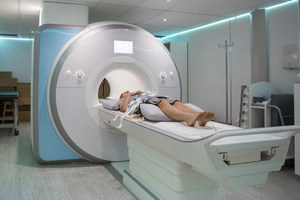
MRI kidney damage
After a car accident in 1995, Nicole, age 47, started to get debilitating migraines. Her neurologist ordered the first MRI with gadolinium-based contrast agent (GBCA) and the scan revealed a brain tumor. “My neurosurgeon was concerned, mainly because of its location and my age and being a young single mother,” says Nicole. “The course of treatment was an MRI every year, and he was hopeful that my brain would heal itself.” Nicole has all her medical records, including gadopentetate dimeglumine (Magnevist), which contains gadolinium.
Just five years later, she was diagnosed with a rare form of Multiple Sclerosis (after five MRIs with the contrast dye) and recently diagnosed with early stage adrenal carcinoma. Only two months ago she had another MRI with contrast dye. Is this toxic heavy metal associated with these diagnoses? Nicole wants answers, and she isn’t getting them from her doctors. She particularly wants to know if gadolinium has caused her kidney problems.
Gadolinium-based contrast agents are used during MRI and MRA exams to help enhance the images, and manufacturers have maintained for years that the toxic metal is safely processed out of the body of individuals with normal kidney function. However, concerns have recently emerged about the risk of gadolinium deposition, with studies showing a host of conditions characterized by retention of gadolinium. Some individuals store remnants of the metal in their brain, or other parts of the body, long after receiving the contrast dye.
From “Aha” to Angry
Nicole is a senior medical assistant, which means she can do everything a nurse can do, except prescribe medications. “By 2007 I got to the point that I wasn’t confident enough to take care of my patients because of my health issues and I had to go on disability in 2009,” says Nicole. “Recently my friends and I –all of whom are in the medical field—were talking about drugs and their side effects, and someone mentioned gadolinium. That was my ‘aha’ moment.”
Then she got angry. “I feel like I was their guinea pig,” Nicole quips. “I know first-hand how drug representatives can cajole doctors into trying new products, the latest and greatest next thing such as these contrast dyes. What about the contrast dyes used before these products with gadolinium? All the years that I was in the medical profession, I never heard a drug representative mentioning side effects. As for gadolinium, I believe there are no long term studies or clinical trials, but I would be a good candidate.”
Nicole is also frustrated with her doctors. They have neither denied nor confirmed that her kidney diagnosis and other health complications could be linked to the heavy metal, possibly because they don’t want to get colleagues involved who ordered the MRIs, and possibly because they simply don’t know. And to top it all off, some research suggests that in many cases, the contrast dye doesn’t need to contain gadolinium. For instance, Virginia recently told LawyersandSettlements that she didn’t need the MRI contrast agent.
READ MORE MRI HEALTH RISK LEGAL NEWS
Nicole has been asked by the top neurosurgeon at Kaiser if they can present her as a case study. “I think it’s great that other doctors want to find out more about gadolinium and my health issues, but I don’t want to feel like a rat in a lab,” Nicole says. “How do I benefit? I’d be willing if they could help me medically somehow. I’m at the end of my rope with these kidney problems and I haven’t gotten anywhere on my own so I’ve turned to legal help. I hope an attorney will back me.”

READER COMMENTS
Zane Besty
on
Zane Beaty
817 703-xxxx
Sandra Langford
on